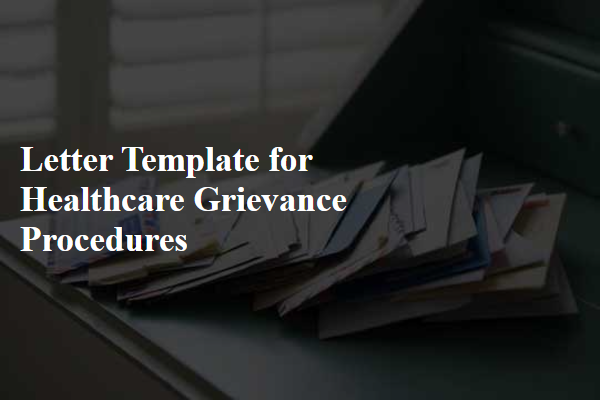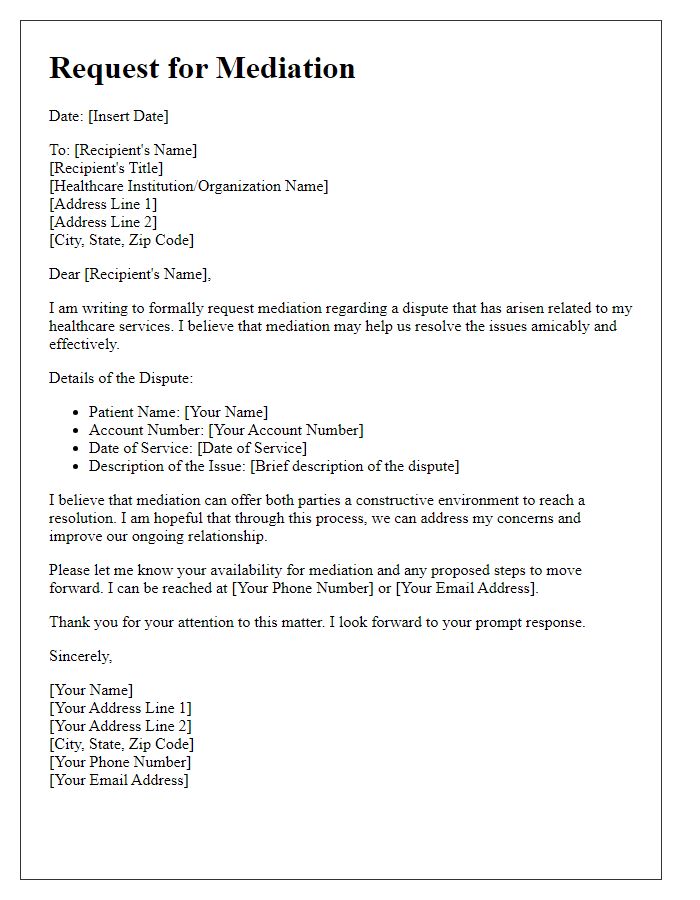Navigating the complexities of healthcare can sometimes lead to dissatisfaction, prompting the need for a formal grievance procedure. If you've ever felt overlooked or miscommunication has occurred during your care, you're not alone. Many patients find themselves in similar situations and can benefit from knowing how to voice their concerns effectively. Join us as we explore the steps to take in crafting your grievance letter, ensuring your voice is heard loud and clearâread on to get started!

Patient Identification and Details
Patient identification is essential in healthcare grievance procedures, ensuring that concerns are accurately attributed and addressed. This typically includes the patient's full name, date of birth, and medical record number (a unique identifier for tracking patient history). Location details, such as the name of the healthcare facility (e.g., City Hospital, Springfield), and department (e.g., Emergency Room) are critical for context. Contact information, including a phone number and email address, allows for direct communication regarding the grievance status. Additionally, documentation pertaining to previous visits or treatments can provide valuable insight into the patient's history and the nature of the grievance, facilitating a thorough and efficient resolution process.
Description of the Issue or Grievance
Patients often experience difficulties in navigating the complexity of healthcare grievance procedures. A common issue arises when individuals encounter delays in receiving critical medical information from healthcare providers, which can compromise their ability to make informed decisions regarding treatment options. Instances of miscommunication, particularly regarding test results or medication side effects, frequently contribute to heightened anxiety levels among patients. The healthcare institution, such as a hospital or clinic, may not have streamlined processes in place to address these urgent concerns efficiently, resulting in prolonged waiting periods for responses. Moreover, insufficient training of staff in direct patient communication can exacerbate misunderstandings, leaving patients feeling unsupported during pivotal moments of their healthcare journey.
Relevant Dates and Timeline
In healthcare grievance procedures, relevant dates and timelines play a crucial role in ensuring a transparent resolution process. The initiation date marks when a patient or caregiver first files a complaint, which must be documented accurately by staff. Subsequently, healthcare facilities typically establish a timeframe, such as 30 days, for investigating the grievance, during which interviews and evidence gathering take place. The response date is when the facility provides feedback to the complainant, outlining findings and proposed resolutions. Should further action be necessary, a follow-up timeline may be required for additional steps, which can include mediation or appeals, often taking an additional 15 to 30 days. Documentation of all dates is essential, as it ensures compliance with regulations and promotes trust between the healthcare provider and the patient community.
Desired Resolution or Outcome
In the healthcare grievance procedure, patients often seek resolutions that address their concerns effectively. Desired outcomes may include a formal apology from the healthcare provider, an in-depth investigation into the incident, reimbursement for medical expenses (ranging from $50 to several thousand dollars), or corrective actions implemented to prevent future occurrences. Stakeholders, such as hospital administrators and patient advocacy groups in specific regions like California or New York, play vital roles in ensuring that grievances are taken seriously and resolved promptly. Clear communication channels and timelines (generally within 30 days for response) are essential for maintaining trust between patients and healthcare organizations. Ensuring that these desired resolutions are met can improve patient satisfaction and overall quality of care.
Contact Information and Next Steps
When addressing healthcare grievances, it is vital to include comprehensive contact information for the relevant department. For instance, the Patient Relations Department at a facility like Johns Hopkins Hospital in Baltimore can often be reached at (410) 955-5000. Next steps after filing a grievance typically involve a thorough review process, which may take up to 30 days, depending on the complexity of the issue. Additionally, patients should document all communication regarding their grievance, including timestamps and names of representatives spoken to, ensuring a clear record of the process. Important elements such as complaint resolution timelines may vary by organization, so understanding specific policies located on the hospital's official website is crucial for effective follow-up.













Comments